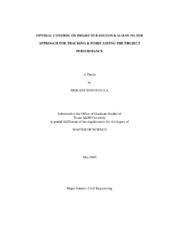| dc.contributor.advisor | Reinschmidt, Kenneth F. | |
| dc.creator | Bondugula, Srikant | |
| dc.date.accessioned | 2010-07-15T00:11:02Z | |
| dc.date.accessioned | 2010-07-23T21:42:48Z | |
| dc.date.available | 2010-07-15T00:11:02Z | |
| dc.date.available | 2010-07-23T21:42:48Z | |
| dc.date.created | 2009-05 | |
| dc.date.issued | 2010-07-14 | |
| dc.date.submitted | May 2009 | |
| dc.identifier.uri | https://hdl.handle.net/1969.1/ETD-TAMU-2009-05-263 | |
| dc.description.abstract | Traditional scheduling tools like Gantt Charts and CPM while useful in planning and execution of complex construction projects with multiple interdependent activities haven?t been of much help in implementing effective control systems for the same projects in case of deviation from their desired or assumed behavior. Further, in case of such deviations project managers in most cases make decisions which might be guided either by the prospects of short term gains or the intension of forcing the project to follow the original schedule or plan, inadvertently increasing the overall project cost.
Many deterministic project control methods have been proposed by various researchers for calculating optimal resource schedules considering the time-cost as well as the time-cost-quality trade-off analysis. But the need is for a project control system which optimizes the effort or cost required for controlling the project by incorporating the stochastic dynamic nature of the construction-production process. Further, such a system must include a method for updating and revising the beliefs or models used for representing the dynamics of the project using the actual progress data of the project. This research develops such an optimal project control method using Kalman Filter forecasting method for updating and using the assumed project dynamics model for forecasting the Estimated Cost at Completion (EAC) and the Estimated Duration at Completion (EDAC) taking into account the inherent uncertainties in the project progress and progress measurements. The controller is then formulated for iteratively calculating the optimal resource allocation schedule that minimizes either the EAC or both the EAC and EDAC together using the evolutionary optimization algorithm Covariance Matrix Adaption Evolution Strategy (CMA-ES). The implementation of the developed framework is used with a hypothetical project and tested for its robustness in updating the assumed initial project dynamics model and yielding the optimal control policy considering some hypothetical cases of uncertainties in the project progress and progress measurements.
Based on the tests and demonstrations firstly it is concluded that a project dynamics model based on the project Gantt chart for spatial interdependencies of sub-tasks with triangular progress rates is a good representation of a typical construction project; and secondly, it is shown that the use of CMA-ES in conjunction with the Kalman Filter estimation and forecasting method provides a robust framework that can be implemented for any kind of complex construction process for yielding the optimal control policies. | en |
| dc.format.mimetype | application/pdf | |
| dc.language.iso | eng | |
| dc.subject | Project Management, Optimal Project Control, Model Estimation, Kalman Filtering | en |
| dc.title | OPTIMAL CONTROL OF PROJECTS BASED ON KALMAN FILTER APPROACH FOR TRACKING & FORECASTING THE PROJECT PERFORMANCE | en |
| dc.type | Book | en |
| dc.type | Thesis | en |
| thesis.degree.department | Civil Engineering | en |
| thesis.degree.discipline | Civil Engineering | en |
| thesis.degree.grantor | Texas A&M University | en |
| thesis.degree.name | Master of Science | en |
| thesis.degree.level | Masters | en |
| dc.contributor.committeeMember | Damnjanovic, Ivan | |
| dc.contributor.committeeMember | Cline, Daren B. | |
| dc.type.genre | Electronic Thesis | en |
| dc.type.material | text | en |


